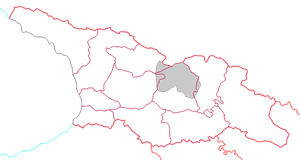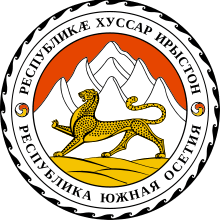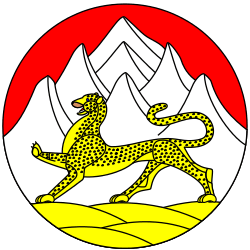Provisional Administration of South Ossetia
| Provisional Administration of South Ossetia სამხრეთ ოსეთის დროებითი ადმინისტრაცია |
||||||
|---|---|---|---|---|---|---|
|
||||||
 Location of South Ossetia (grey) in Georgia.
|
||||||
| Capital | ||||||
| Official languages | ||||||
| Government | Exiled Provisional administration | |||||
| • | Head | Dmitry Sanakoyev[1] | ||||
| • | Interior Minister | Jemal Karkusov | ||||
| Provisional governmentb | ||||||
| • | Established | April 2007 | ||||
| Currency | Georgian lari (GEL) | |||||
| Time zone | GET (UTC+4) | |||||
| a. | Initially, the administration was based in Kurta and was administering the settlements and territory outside the separatists' control. This territory was lost as a result of the 2008 South Ossetia War and thus the administration is now in exile. | |||||
| b. | The administration was set up by the Georgian government as a temporary measure before the settlement of South Ossetia's status. As of June 26, 2007, Georgia is proposing the status of autonomous republic within the Georgian state. | |||||
The Provisional Administration of South Ossetia (Georgian: სამხრეთ ოსეთის დროებითი ადმინისტრაცია, Samkhret' Oset'is droebit'i administrats'ia) is an administrative body that Georgia regards as the legal government of South Ossetia. The administration was set up by the Georgian government as a transitional measure leading to the settlement of South Ossetia's status. As of 2007, Georgia is proposing the status of autonomous republic within the Georgian state. The area mainly lies within the Shida Kartli region.
History
 |
| This article is part of a series on the politics and government of South Ossetia |
| See also |
The Salvation Union of South Ossetia was founded in October 2006 by the ethnic Ossetians who were outspoken critics and presented a serious opposition to secessionist authorities of Eduard Kokoity.
The group headed by the former defence minister and then prime minister of secessionist government Dmitri Sanakoev organized the so-called alternative presidential election, on November 12, 2006– parallel to those held by the secessionist authorities in Tskhinvali.[2] High voter turnout was reported by the alternative electoral commission, which estimated over 42,000 voters from both Ossetian (Java district and Tskhinvali) and Georgian (Eredvi, Tamarasheni, etc.) communities of South Ossetia and Sanakoev reportedly received 96% of the votes. Another referendum was organised shortly after asking for the start of negotiations with Georgia on a federal arrangement for South Ossetia received 94% support. However the Salvation Union of South Ossetia turned down a request from a Georgian NGO, “Multinational Georgia”, to monitor it and the released results were very likely to be inflated.[3]
“I, the President of the Republic of South Ossetia, declare before God and Nation that I will protect the interests of the South Ossetian people... I will take care of the security, well-being and revival of South Ossetia and its people,”
Dimitri Sanakoev said in his presidential oath, which he gave in the Ossetian and Georgian languages during the inauguration ceremony held on December 1, 2006.[4]
Soon after Sanakoev formed his government, appointing Uruzmag Karkusov as Prime Minister, Jemal Karkusov (former Interior Minister in the secessionist government) as Interior Minister and Maia Chigoeva-Tsaboshvili (head of the Tbilisi-based non-governmental organization Iber-Ironi Georgian-Ossetian Union) as Foreign Minister.[5]
“This is a historic day. A year ago no one could imagine that South Ossetian flags could appear here in the Georgian-populated village,” Vladimir Sanakoev, co-founder of the Salvation Union of South Ossetia, said.[6]
There were large number of Ossetian flags also used by the South Ossetian secessionist authorities, flown alongside the Georgian flag in Kurta, near Tskhinvali. South Ossetian flags are usually displayed in Tskhinvali by the Separatist controlled territories of the breakaway region alongside of the Russian national flag.
Both the central Georgian government and Sanakoyev's administration considers any negotiations with Kokoity's government meaningless because of its dependence on Moscow. On the other hand, the Tskhinvali leadership and a majority of South Ossetians in the areas it controls dismiss Sanakoev as a "traitor" and perceive that Georgia wants to force a settlement on its own terms having "little respect for their aspirations and fears".[3]
Initially the entity of Sanakoev was known as "the Alternative Government of South Ossetia", but during the course of 2007 the central authorities of Georgia decided to give it official status and on April 13 the formation of "Provisional Administration of South Ossetia" was announced.[7] On May 10, 2007 Dmitry Sanakoev was appointed head of the provisional administration in South Ossetia.[1]
For the first time since the fall of Soviet Union, the former Ossetian secessionist leader gave a speech in the Georgian parliament on May 11, 2007.
In his speech in Ossetian language (full text), Sanakoev mentioned about the armed conflict which ignited the region in early 90s:
| “ | “Many of [Ossetians] took arms [in early 90s] and I was among them. But we all have understood that armed confrontation brought nothing but misfortune… It became clear for us that we were in impasse.” | ” |
He also mentioned that:
| “ | “vicious Soviet legacy, grave mistakes committed by the both sides and the imperialistic policy of divide and rule exerted by the external forces.” [8] | ” |
Sanakoev also mentioned that despite of his high-level position in the South Ossetian secessionist authorities as Prime Minister he failed to build confidence between the two sides and make a breakthrough in the conflict resolution process “because it was beyond my powers.”
| “ | “There is only one solution – direct dialogue between the Georgian and Ossetian people, neutralizing external and internal destructive forces and their replacement with effective and healthy support of the international democratic community. European Union’s role in respect of confidence-building and economic rehabilitation is of vital importance. We should counter-balance antidemocratic propaganda by our movement’s brave peaceful initiatives and economic development projects,” | ” |
.
As for current situation, Sakanoev mentioned that Tskhinvali secessionist authorities take instruction from “foreign supervisors” who try to thwart confidence-building and provoke hostilities between the two people.
"Our Ossetian children grow up in an environment of endless conflict, under constant stress and tension… They don’t know what is going on beyond checkpoints… We are losing entire generations,” “I will not allow it! We should not allow it,” he added. “This is our current challenge; this is our current goal: to create a new Ossetia, strong and delightful, free of violence: an Ossetia of free people.”
Many European and US observers and ambassadors who were present during Sanakoevs speech, welcomed his proposition and initiatives. On June 15, 2007 European Union, European Parliament and OSCE supported Georgian initiative for conflict settlement in South Ossetia. EU issued the following statement:
"The EU welcomes the Georgian government’s invitation to the South Ossetian society as a whole – i.e. representatives of all political forces and local groups – to participate actively in discussions on progress towards peaceful conflict resolution.”[9]
The EU mission had met with both Sanakoev and Kokoity in January, 2007. Per Eklund, Head of the European Commission Delegation to Georgia said that “None of the two alternatives do we consider legitimate [in South Ossetia],” [10]
On July 13, 2007, Georgia set up a state commission, chaired by the Prime Minister Zurab Noghaideli, to develop South Ossetia's autonomous status within the Georgian state. According to the Georgian officials, the status will be elaborated within the framework of "an all-inclusive dialogue" with all the forces and communities within the Ossetian society.[11]
2008 war
On August 8, 2008, the same day as the 2008 Olympic Games officially commenced, Georgian armed forces moved forward to take control of Tskhinvali. In the next few days, Russian troops pushed back the Georgian army out of South Ossetia and moved farther, occupying Gori in Georgia proper. Following the end of hostilities, the Federation Council of Russia called an extraordinary session for August 25, 2008 to discuss recognition of Abkhazia and South Ossetia.[12] On August 25, the Federation Council unanimously voted to ask the Russian President to recognise independence of South Ossetia and Abkhazia.[13] The Russian parliament voted in favour of this motion the following day. This unilateral recognition by Russia was met by condemnation from some members of the United Nations (including France, Germany, Great Britain and the United States) and from NATO, the Organization for Security and Co-operation in Europe and the European Council, due to the violation of Georgia's territorial integrity, of numerous United Nations resolutions on Abkhazia and of international law.[14][15][16][17]
See also
References
- 1 2 Online Magazine - Civil Georgia
- ↑ Two Referendums and Two “Presidents” in South Ossetia - CAUCAZ.COM
- 1 2 Georgia’s South Ossetia Conflict: Make Haste Slowly, Europe Report N°183, 7 June 2007 (free registration needed to view full report)
- ↑ Online Magazine - Civil Georgia
- ↑ Online Magazine - Civil Georgia
- ↑ Online Magazine - Civil Georgia
- ↑ Online Magazine - Civil Georgia
- ↑ Online Magazine - Civil Georgia
- ↑ Online Magazine - Civil Georgia
- ↑ Online Magazine - Civil Georgia
- ↑ Commission to Work on S.Ossetia Status. Civil Georgia July 13, 2007.
- ↑ Halpin, Tony (2008-08-20). "Russia to recognise breakaway region's independence". London: The Times. Retrieved 2008-08-20.
- ↑ "Upper chamber backs independence of Abkhazia and South Ossetia". Russia Today. 2008-08-25.
- ↑ West condemns Russia over Georgia, BBC, 26 August 2008
- ↑ Scheffer ‘Rejects’ Russia’s Move, Civil.ge, August 26, 2008
- ↑ CoE, PACE Chairs Condemn Russia’s Move, Civil Georgia, 26 August, 2008
- ↑ OSCE Chair Condemns Russia’s Recognition of Abkhazia, S.Ossetia, Civil Georgia, 26 August, 2008


.svg.png)